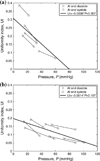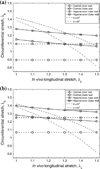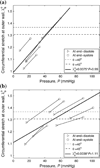Impact of residual stretch and remodeling on collagen engagement in healthy and pulmonary hypertensive calf pulmonary arteries at physiological pressures
- PMID: 22237861
- PMCID: PMC3593651
- DOI: 10.1007/s10439-012-0509-4
Impact of residual stretch and remodeling on collagen engagement in healthy and pulmonary hypertensive calf pulmonary arteries at physiological pressures
Abstract
Understanding the mechanical behavior of proximal pulmonary arteries (PAs) is crucial to evaluating pulmonary vascular function and right ventricular afterload. Early and current efforts focus on these arteries' histological changes, in vivo pressure-diameter behavior and mechanical properties under in vitro mechanical testing. However, the in vivo stretch and stress states remain poorly characterized. To further understand the mechanical behavior of the proximal PAs under physiological conditions, this study computed the residual stretch and the in vivo circumferential stretch state in the main pulmonary arteries in both control and hypertensive calves by using in vitro and in vivo artery geometry data, and modeled the impact of residual stretch and arterial remodeling on the in vivo circumferential stretch distribution and collagen engagement in the main pulmonary artery. We found that the in vivo circumferential stretch distribution in both groups was nonuniform across the vessel wall with the largest stretch at the outer wall, suggesting that collagen at the outer wall would engage first. It was also found that the circumferential stretch was more uniform in the hypertensive group, partially due to arterial remodeling that occurred during their hypoxic treatment, and that their onset of collagen engagement occurred at a higher pressure. It is concluded that the residual stretch and arterial remodeling have strong impact on the in vivo stretch state and the collagen engagement and thus the mechanical behavior of the main pulmonary artery in calves.
Conflict of interest statement
No conflicts of interest, financial or otherwise, are declared by the author(s).
Figures









References
-
- Burton AC. Relation of structure to function of the tissues of the wall of blood vessels. Physiol. Rev. 1954;34:619–642. - PubMed
-
- Cacho F, Elbischger PJ, Rodríguez JF, Doblaré M, Holzapfel GA. A constitutive model for fibrous tissues considering collagen fiber crimp. Int. J. Nonlinear Mech. 2007;42:391–402.
-
- Canham PB, Finlay HM, Dixon JG, Boughner DR, Chen A. Measurements from light and polarised light microscopy of human coronary arteries fixed at distending pressure. Cardiovasc. Res. 1989;23:973–982. - PubMed
-
- Carew TE, Vaishnav RN, Patel DJ. Compressibility of the arterial wall. Circ. Res. 1968;23:61–68. - PubMed
-
- Chuong CJ, Fung YC. Compressibility and constitutive equation of arterial wall in radial compression experiments. J. Biomech. 1984;17:35–40. - PubMed
Publication types
MeSH terms
Substances
Grants and funding
LinkOut - more resources
Full Text Sources
Medical

